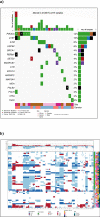Genomic profiles and clinical presentation of chordoma
- PMID: 39135136
- PMCID: PMC11318126
- DOI: 10.1186/s40478-024-01833-9
Genomic profiles and clinical presentation of chordoma
Abstract
Chordoma is a rare bone cancer with variable clinical outcomes. Here, we recruited 184 sporadic chordoma patients from the US and Canada and collected their clinical and treatment data. The average age at diagnosis was 45.5 years (Range 5-78) and the chordoma site distribution was 49.2% clivus, 26.2% spinal, and 24.0% sacral. Most patients (97.5%) received surgery as the primary treatment, among whom 85.3% also received additional treatment. Except for the most prevalent cancers like prostate, lung, breast, and skin cancer, there was no discernible enrichment for any specific cancer type among patients or their family members. Among a subset of patients (N = 70) with tumor materials, we conducted omics analyses and obtained targeted panel sequencing and SNP array genotyping data for 51 and 49 patients, respectively. The most recurrent somatic driver mutations included PIK3CA (12%), followed by chromatin remodeling genes PBRM1 and SETD2. Amplification of the 6q27 region, containing the chordoma susceptibility gene TBXT, was detected in eight patients (16.3%). Clival patients appeared to be less likely to carry driver gene mutations, chromosome arm level deletion events (e.g., 5p, 5p, and 9p), or 6q27 amplification compared to sacral patients. After adjusting for age, sex, tumor site, and additional treatment, patients with somatic deletions of 14q (OR = 13.73, 95% CI 1.96-96.02, P = 0.008) and 18p (OR = 13.68, 95% CI 1.77-105.89, P = 0.012) were more likely to have persistent chordoma. The study highlights genomic heterogeneity in chordoma, potentially linked to location and clinical progression.
Keywords: Chordoma; Chordoma sites; Clinical outcome; Genomic landscape; Treatment.
© 2024. This is a U.S. Government work and not under copyright protection in the US; foreign copyright protection may apply.
Conflict of interest statement
The authors declare that they have no competing interests.
Figures


References
-
- Parry DM, McMaster ML, Liebsch NJ, Patronas NJ, Quezado MM, Zametkin D et al (2020) Clinical findings in families with chordoma with and without T gene duplications and in patients with sporadic chordoma reported to the surveillance, epidemiology, and end results program. J Neurosurg. 134(12):1399–1408 - PMC - PubMed
Publication types
MeSH terms
Substances
LinkOut - more resources
Full Text Sources
Miscellaneous

